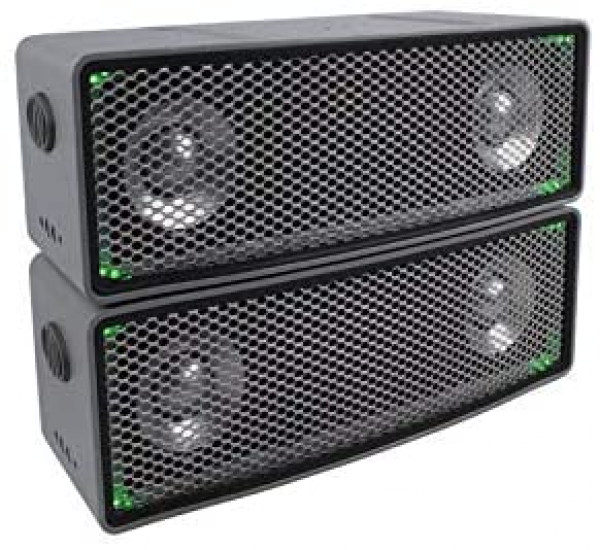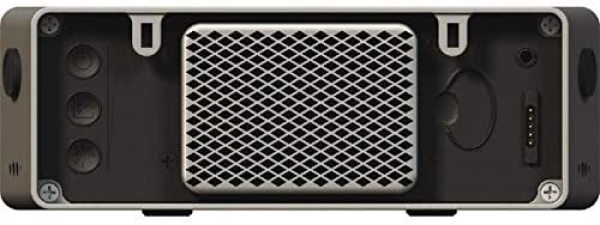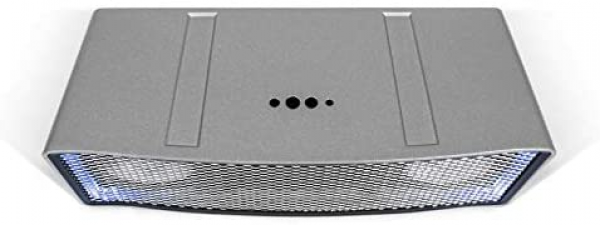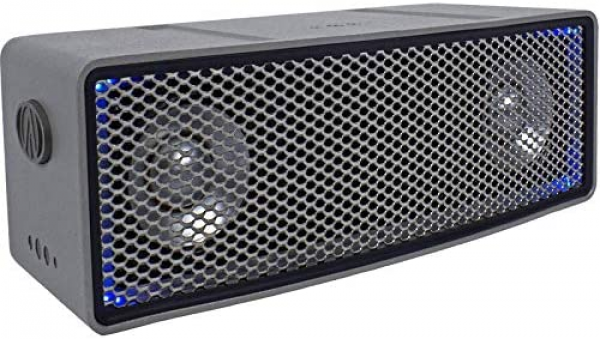aiFi
AiFi Ai-1: The stackable portable speaker
Aprox. 249€
See specificationsThe Ai-1 is the first portable speaker from the young Swedish manufacturer aiFi. Very classic in appearance, it does however embark on a rather unexpected functionality: the possibility of stacking several copies to combine them into a single enclosure, of multiplied power.
Positive points
Power.
Remarkably mastered distortion.
Stereophonic width.
Optical S / PDIF input.
Very impressive effect of vertical stacking ...
Bad points
... but watch out for the degradation of the treble from 3 speakers.
Effect of horizontal association much less convincing.
Very insufficient manufacturing quality.
Nebulous ergonomics, pitiful mobile app.
Very limited autonomy.
The sound signature will not suit everyone.
Our review
Ergonomics
The very rough exterior appearance, very industrial of the Ai-1 lets imagine a certain robustness of manufacture. Unfortunately, this is not the case: the first physical contact with the enclosure is extremely disappointing. Despite its aluminum envelope and its generous weight (750 grams, almost 100 g more than a Bose Soundlink Mini II), the finishes are not of great luxury. The speaker sounds hollow when you tap it, the visible screws are legion on the rear facade ... As for the grids covering speakers and bass radiator, if their chrome tint tries to make them pass for robust steel, it is actually a very light , flexible, and frankly cheap mesh.
The Bluetooth connectivity (aptX compatible) of the Ai-1 is supplemented by an optical analog / digital combo input on 3.5 mm mini-jack. The rear panel accommodates three control buttons: a first on / standby button, a second button for selecting the input, and a third button for controlling the color and intensity of the light emitted by the RGB LEDs that surround the speakers. Entirely tactile, these buttons are not models of ergonomics, especially since the functions which are allotted to them are rather little instinctive. For example, switching between entries is not done by pressing the appropriate button ... but by pressing twice. Why this complication? In addition, a command as basic as adjusting the volume does not have a dedicated button, and must be done by sliding your finger up or down on the three buttons. It should have been less convoluted.
Finally, note that the Ai-1 does not have a hands-free kit functionality, nor any on-board navigation control (play / pause, change of track ...)
In addition to its decorative function, the RGB light on the front also serves as a status indicator. A slow flash indicates for example the entry of the speaker in Bluetooth pairing mode (activated by a long press on the input selection button), while a double press on the ignition button makes it indicate the level of battery by a brief change of color, covering the whole palette from green (full battery) to red (impending dry breakdown).
Finally comes the time to discuss the specificity of this enclosure, its ability to stack. Several Ai-1 can be nested together, either vertically (the feet of one of them are housed in the guides on the upper side of another), or laterally (the guidance is done using small aluminum parts, removable and magnetized, on the sides of the enclosure). The speakers then communicate with each other via a proprietary wireless protocol, all adopt the same illumination color, and all broadcast the same sound flow. The association is immediate and is always done without the slightest problem.
An application for the Ai-1 is available on iOS and Android. It allows direct access from a smartphone to the volume adjustment, as well as to the color and intensity settings of the RGB LEDs. We will also go through it to update the firmware of the speaker. But the most interesting of the functionalities is an operating mode called PartyQueue: if several speakers each connected to a different Bluetooth source are assembled in a stack, the application allows you to choose which of these sources is distributed by the whole.
Unfortunately, this app is very unsatisfactory. In addition to the many bugs and crashes to which it regularly engages, it is sluggish and difficult to understand and quite catastrophic ergonomics - simple navigation between the panes of the app, by lateral sliding of the finger on the screen, only works very sporadically. It is extremely frustrating.
We measured the autonomy of the Ai-1 at around 6 hours - two less than what the data sheet had promised us. In absolute terms, this is very weak, since a number of competitors today offer twice as much. However, this figure must be put into perspective by evoking the sensational power of the speaker; what we are going to do below.

Audio
For a few years now, in the world of headphones, there has been fashion for products for "bassheads", those who love big bass. Taking the opposite view of this, the Ai-1 could almost be seen as an enclosure for "trebleheads".
The aiFi speaker has a very marked V-shaped signature: the constant and very sharp rise in frequency response from 1 kHz translates into an extremely brilliant sound, very rich in sibilants and high harmonics. Fortunately, and quite remarkably, these high frequencies are very clean and do not show a tendency to sibilance. Their aggressiveness therefore remains relatively contained. It should also be noted that these trebles are extremely tight vertical directivity: this is shown by the measurement in red on our frequency response graph, performed at an angle of 45 ° in height. At this angle, the spectral profile of the speaker is significantly softened, and allows the mid frequencies to regain some presence.
Nothing, however, can calm the hump in the bass, around 200 Hz, intended to compensate for an extension in the bass necessarily limited, given the size of the speaker. Again, the thing is done very cleanly, with a very controlled distortion, and therefore without too much boomy effect. However, there is a slight masking of neighboring frequencies. This can be problematic on music very rich in low mediums (orchestral music, for example), which lose a lot of naturalness and detail.
The speaker can boast of a stereophonic width excellent for its size. Its horizontal emission cone is surprisingly wide and allows the establishment of an unexpected scene depth for a portable speaker.
But we have saved the best for the end: it is the power play that the Ai-1 impresses the most. With its remarkably controlled distortion, it takes on a very generous amplification capable of raising the VU meter to frankly surprising heights. If, in our measurement protocols, we are used to measuring portable speakers at a volume of 79 dB SPL at one meter, we could easily for this model make measurements at 85 dB SPL, the value we reserve usually to sedentary speakers. And what is true for a single speaker is obviously even more so for several stacked speakers.
Stacking two speakers therefore automatically increases the volume by 6 dB, while adding a third pushes it further by 3.5 dB, and so on: a virtually unlimited number of speakers can be combined. The result is really impressive ... but the operation is not completely smooth either: as efficient as the proprietary communication between the speakers, it also does not guarantee sufficient synchronization accuracy for the sound waves emitted across all speakers remain perfectly consistent across the entire audible spectrum. The result is an attenuation above 8 kHz without gravity at two speakers, but much more annoying at three. The sound then becomes quite dull and metallic and the listening pleasure is significantly compromised.
These observations are only valid for vertical stacking. When the speakers are linked horizontally, the aiFi documentation tells us that a technology called Sound Dimension then sets to work to improve the stereo image of the Ai-1s, but we have heard absolutely nothing like it in our tests. The alignment of all the loudspeakers on the same axis made us especially hear serious interference problems, causing very unpleasant comb filtering. We therefore advise you to avoid this configuration as much as possible.
Let's conclude with the usual last word on Bluetooth latency. Measured at around 175 ms, it is in the lower range of what is usually observed on wireless speakers. It can therefore allow the occasional viewing of videos without too much discomfort, even if it is as always recommended to compensate for this difference via the playback software, as far as possible.

Conclusion
It's hard not to be impressed by the power potential of the Ai-1, already astonishing when it is alone, properly crazy when it is associated with several of its sisters - and all this without any annoying distortion. Too bad the manufacturing quality and ergonomics are not up to par. Also pay attention to the very marked V-shaped sound signature of the beast, which will certainly not make everyone happy.

Specifications

